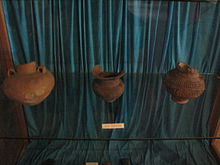- Coțofeni culture
-
The Coţofeni culture (Serbian: Kocofeni) is a Chalcolithic to Early Bronze Age culture that existed for over 700 years in the south-eastern part of Central Europe.
The first report of a Coţofeni find was given by Fr. Schuster[1] in 1865 from the Râpa Roşie site in Sebeş (present-day Alba County, Romania). Since then this culture has been researched by various people to different degrees. Some of the larger contributors to the study of this culture are C. Gooss, K. Benkő, B. Orbán, G. Téglas, K. Herepey, S. Fenichel, Julius Teutsch, Cezar Bolliac, V. Christescu, Teohari Antonescu and Cristian Popa.
Contents
Geographic Area
The Coţofeni cultural area can be seen from two perspectives, as a maximum extent area and as a fluctuation area. The former covers the territories of present day Maramureş, some areas in Sătmar, the mountainous and hilly areas of Crişana, Transylvania[2][3], Banat[4], Oltenia[5], Muntenia (not including the North-Eastern part) and across the Danube in the present day north-eastern region of Serbia and north-western region of Bulgaria[6].
Chronology
Absolute Chronology
Unfortunately most of the absolute chronology of the Coţofeni culture is based on just three samples collected in three Coţofeni sites. Based on these radiocarbon dates, the evolution of this culture can be placed roughly between 3500 and 2500 BCE.[7]
Relative Chronology
Cultural synchronisms have been established based on mutual trade relations (visible as imported items) as well as stratigraphical observations. A synchronicity between Coţofeni I - Cernavoda III - Baden A - Spherical Amphorae; Coţofeni II - Baden B-C Kostolac;[8][9] Coţofeni III - Kostolac-Vučedol A-B.
Relations with Contemporary Neighbouring Cultures
During the evolution of the Coţofeni culture, there are clearly relationships with other neighbouring cultures. The influence between the Coţofeni and their neighbours the Baden, Kostolac,[10] Vučedol, Globular Amphora culture as well as the Ochre Burial populations was reciprocal. The areas bording these cultures show cultural traits that have mixed aspects, for example Coţofeni-Baden[11][12] and Coţofeni-Kostolac finds. These finds of mixed aspects suggest a cohabitation between related populations.[13] It also supports the idea of well established trade between cultures.
References
- ^ Fr. W. Schuster, 1867, Ueber alte Begräbnikftätten bei Mühlbach, în Programm des evanghelische Untergymnasium zu Mühlbach, 1866-1867, p. 3-16.
- ^ H. Ciugudean, 1996, Perioada timpurie a epocii bronzului în centrul şi sud-vestul Transilvaniei, Bibliotheca Thracologica, XIII, Bucharest, 1996.
- ^ Z. Kalmar, 1983, Descoperiri Coţofeni în bazinul someşan (Someşuri, Crasna, Almaş), in ActaMP, VII, 1983, p. 61-68.
- ^ H. Ciugudean, 2000, Eneoliticul final în Transilvania şi Banat: cultura Coţofeni, Bibliotheca Historica et Archaeologica Banatica, Timişoara, 2000.
- ^ D. Berciu, 1939, Arheologia preistorică a Olteniei, Craiova, 1939.
- ^ S. Alexandrov, 1990, Cultura Coţofeni în Bulgaria (Doctoral thesis, advisor. D. Berciu), Bucharest, 1990 (mss.).
- ^ P. Raczky, 1995, New data on the absolute chronology of the Copper age in the Carpathian Basin, în Neure Daten zur Siedlungsgeschichte und Chronologie der Kupferzeit des Karpatenbeckens, Inventaria Praehistorica Hungarie, Budapest, 1995, p. 51-60.
- ^ P. I. Roman, 1977, Noţiunea de “cultura Kostolac”, in SCIVA, 28, 1977, 3, p. 419-429.
- ^ P. I. Roman, 1980, Der “Kostolac-Kultur”-Begriff nach 35 Jahren, in PZ, 55, 1980, 2, p. 220-227.
- ^ D. Nikolić, 2000, Kostolačka kultura na teritoriji Srbje, Centre for Archaeological Research, 19, Beograd, 2000.
- ^ I. Emödi, 1984, Descoperiri ale culturilor Coţofeni şi Baden în peşterile Igriţa şi Izbândiş, in ActaMN, XXI, 1984, p. 405-431.
- ^ S. Morintz, P. Roman, 1973, Über die Übergangsperiode vom Äneolithikum zur Bronzezeit in Rumänien, in Symposium Badener Kultur, Bratislava, 1973, p.259-295.
- ^ P. I. Roman, 1982, Constituirea noilor grupe etnoculturale de la începutul epocii bronzului, in Carpica, XIV, 1982, p. 39-49.
Categories:- Archaeological cultures
- Copper Age Europe
- Archaeology of Romania
- Archaeology of Serbia
- Archaeology of Bulgaria
- Prehistory of Southeastern Europe
- History of Romania
- Archaeological cultures in Romania
Wikimedia Foundation. 2010.

